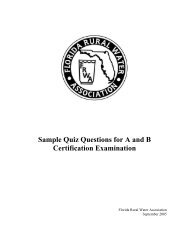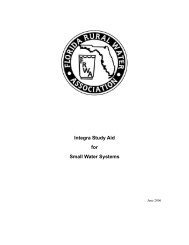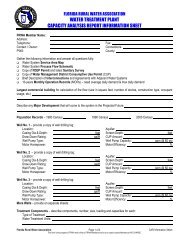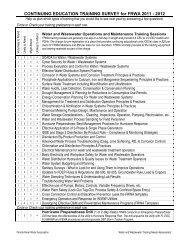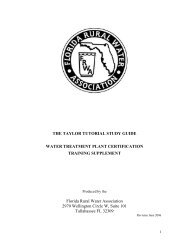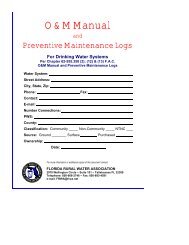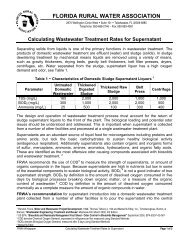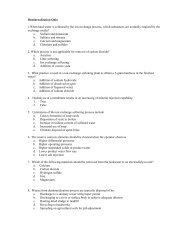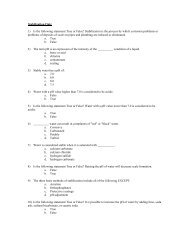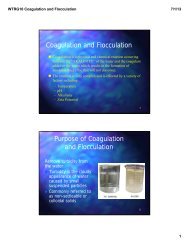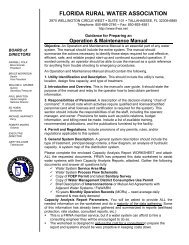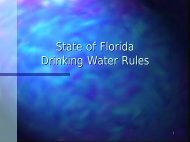1 Production of Chloramines and Chloramine ... - Save the Water
1 Production of Chloramines and Chloramine ... - Save the Water
1 Production of Chloramines and Chloramine ... - Save the Water
You also want an ePaper? Increase the reach of your titles
YUMPU automatically turns print PDFs into web optimized ePapers that Google loves.
continuously added. The Y-axis shows <strong>the</strong> total chlorine residual that is measured. Total<br />
chlorine is in a combined form (Y axis) until all <strong>the</strong> inorganic <strong>and</strong> organic dem<strong>and</strong> is<br />
satisfied, in o<strong>the</strong>r words until <strong>the</strong> initial inorganic <strong>and</strong> organic dem<strong>and</strong> has been satisfied,<br />
no hypochlorous acid is available. For each source water <strong>the</strong> breakpoint curve will be<br />
unique but it will follow <strong>the</strong> general pattern shown below.<br />
Note that between <strong>the</strong> segments labeled 1 <strong>and</strong> 2, although free chlorine has been added,<br />
no chlorine residual <strong>of</strong> any kind is shown on <strong>the</strong> left Y-axis. This is because within this<br />
range <strong>the</strong> chlorine is reacting with inorganic constituents in <strong>the</strong> water such as iron,<br />
manganese, hydrogen sulfide <strong>and</strong> any ammonia that may be naturally present. This<br />
oxidation-reduction reaction will proceed to completion until all inorganic substrate is<br />
consumed. What is important to note here is, that no reaction with organic materials<br />
present in <strong>the</strong> water will take place until all <strong>the</strong> inorganic dem<strong>and</strong> has been satisfied.<br />
Within this range, free chlorine may be added to <strong>the</strong> water without producing any<br />
significant disinfection byproducts. This concept is important because many Florida<br />
water sources contain iron, hydrogen sulfide <strong>and</strong> background ammonia all inorganic<br />
dem<strong>and</strong>ing substances.<br />
Between segments 2 <strong>and</strong> 3, <strong>the</strong>re is no longer any un-reacted inorganic compounds in <strong>the</strong><br />
water <strong>and</strong> oxidation <strong>of</strong> organic contaminants that produce disinfection by-products will<br />
now occur. To prevent this undesirable situation from occurring, many water treatment<br />
plants with disinfection byproduct problems have switched to <strong>the</strong> use <strong>of</strong> chloramines.<br />
<strong>Chloramine</strong> is produced by adding ammonia, in a ratio <strong>of</strong> between 3 to 5 parts measured<br />
as free chlorine to 1 part ammonia. If chlorine is added at a higher ratio, <strong>the</strong>n <strong>the</strong><br />
chloramine will transition from <strong>the</strong> monochloramine form to <strong>the</strong> dichloramine form as<br />
shown past point 3 on <strong>the</strong> curve. Note that <strong>the</strong>se ratios apply only after inorganic chlorine<br />
dem<strong>and</strong> has been satisfied. This is why it is important for plants to develop <strong>the</strong>ir unique<br />
breakpoint chlorination curves.<br />
4



